tow CHEVROLET TRACKER 1998 1.G User Guide
[x] Cancel search | Manufacturer: CHEVROLET, Model Year: 1998, Model line: TRACKER, Model: CHEVROLET TRACKER 1998 1.GPages: 386, PDF Size: 21.17 MB
Page 69 of 386
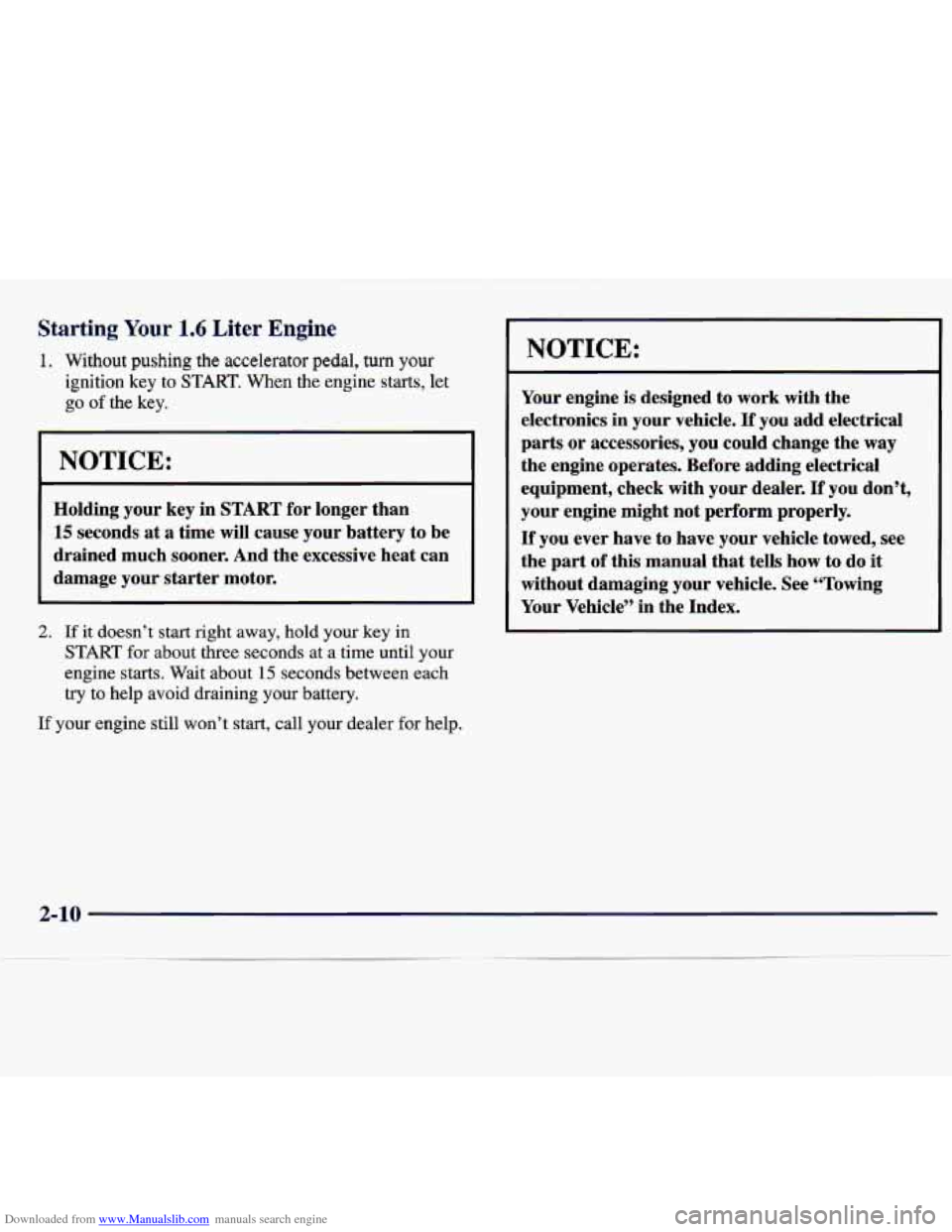
Downloaded from www.Manualslib.com manuals search engine Starting Your 1.6 Liter Engine
1. Without pushing the accelerator pedal, turn your
ignition key to START. When the engine starts, let
go of the key.
NOTICE:
Holding your key in START for longer than
15 seconds at a time will cause your battery to be
drained much sooner. And the excessive heat can
damage your starter motor.
2. If it doesn’t start right away, hold your key in
START for about three seconds at a time until your
engine starts. Wait about
15 seconds between each
try to help avoid draining your battery.
If your engine still won’t start, call your dealer for help.
NOTICE:
Your engine is designed to work with the
electronics in your vehicle.
If you add electrical
parts or accessories,
you could change the way
the engine operates. Before adding electrical
equipment, check with your dealer.
If you don’t,
your engine might not perform properly.
If you ever have to have your vehicle towed, see
the part of this manual that tells how to do
it
without damaging your vehicle. See “Towing
Your Vehicle” in the Index.
2-10
Page 70 of 386
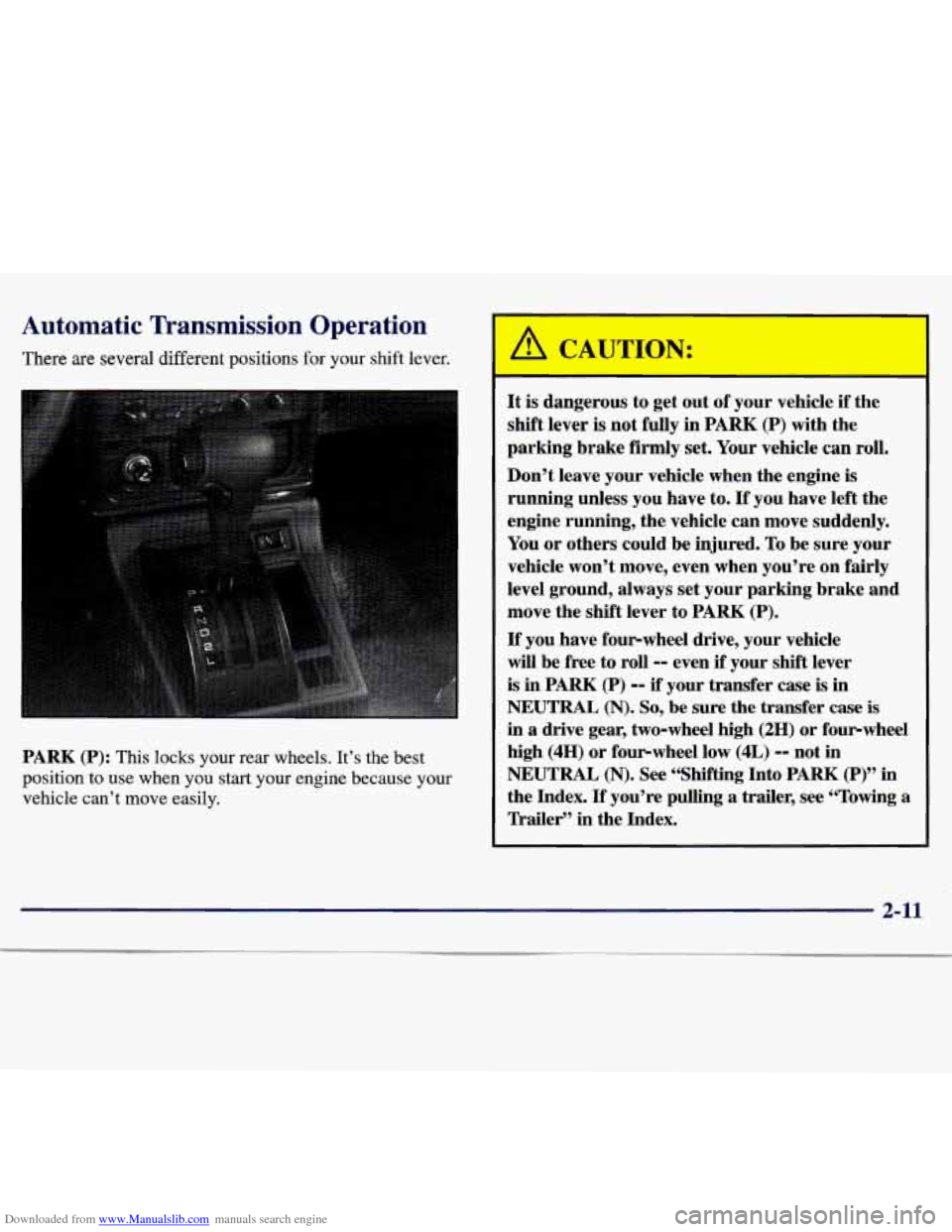
Downloaded from www.Manualslib.com manuals search engine Automatic Transmission Operation
There are several different positions for your shift lever.
PARK
(P): This locks your rear wheels. It’s the best
position to use when
you start your engine because your
vehicle can’t move easily. It
is dangerous to
get out of your vehicle if the
shift lever is not fully in
PARK (P) with the
parking brake firmly
set. Your vehicle can roll.
Don’t leave your vehicle when the engine is
running unless you have to.
If you have left the
engine running, the vehicle can move suddenly.
You or others could be injured. To be sure your
vehicle won’t move, even when you’re
on fairly
level ground, always set your parking brake and
move the shift lever to PARK
(P).
If you have four-wheel drive, your vehicle
will be free to roll
-0 even if your shift lever
is in PARK (P) -- if your transfer case is in
NEUTRAL (N). So, be sure the transfer case is
in a drive gear, two-wheel high (2H) or four-wheel
high (4H) or four-wheel low (4L)
-- not in
NEUTRAL
(N). See “Shifting Into PARK (P)” in
the Index.
If you’re pulling a trailer, see “Towing a
lkailer” in the Index.
2-11
Page 71 of 386

Downloaded from www.Manualslib.com manuals search engine Ensure the shift lever is fully in PARK (P) before starting
the engine. Your vehicle has a brake-transmission shift
interlock. You
have to fully apply your regular brakes
before you can shift from PARK (P) when the ignition
key is in
ON. If you cannot shift out of PARK (P), ease
pressure on the shift lever
-- push the shift lever all the
way into PARK (P) and release the shift lever button as
you maintain brake application. Then press the shift lever
button
and move the shift lever into the gear you wish.
See “Shifting Out of
PARK (P)” in the Index.
REVERSE (R): Use this gear to back up.
NOTICE:
Shifting to REVERSE (R) while your vehicle
is moving forward could damage your
transmission. Shift to REVERSE (R) only
after your vehicle is stopped.
To rock your vehicle back and forth to get out of snow,
ice or sand without damaging your transmission, see
“Stuck: In Sand, Mud, Ice or Snow” in the Index. NEUTRAL
(N): In this position, your engine doesn’t
connect with
the wheels. To restart when you’re
already moving,
use NEUTRAL (N) only. Also, use
NEUTRAL (N) when your vehicle is being towed.
Shifting out of
PARK (P) or NEUTRAL (N)
while your engine is “racing” (running at high
speed)
is dangerous. Unless your foot is firmly on
the brake pedal, your vehicle could move very
rapidly. You could lose control and hit people or
objects. Don’t shift out of
PARK (P) or
NEUTRAL
(N) while your engine is racing.
I NOTICE:
Damage to your transmission caused by shifting
out of PARK
(P) or NEUTRAL (N) with the
engine racing isn’t covered by your warranty.
1
2-12
Page 79 of 386
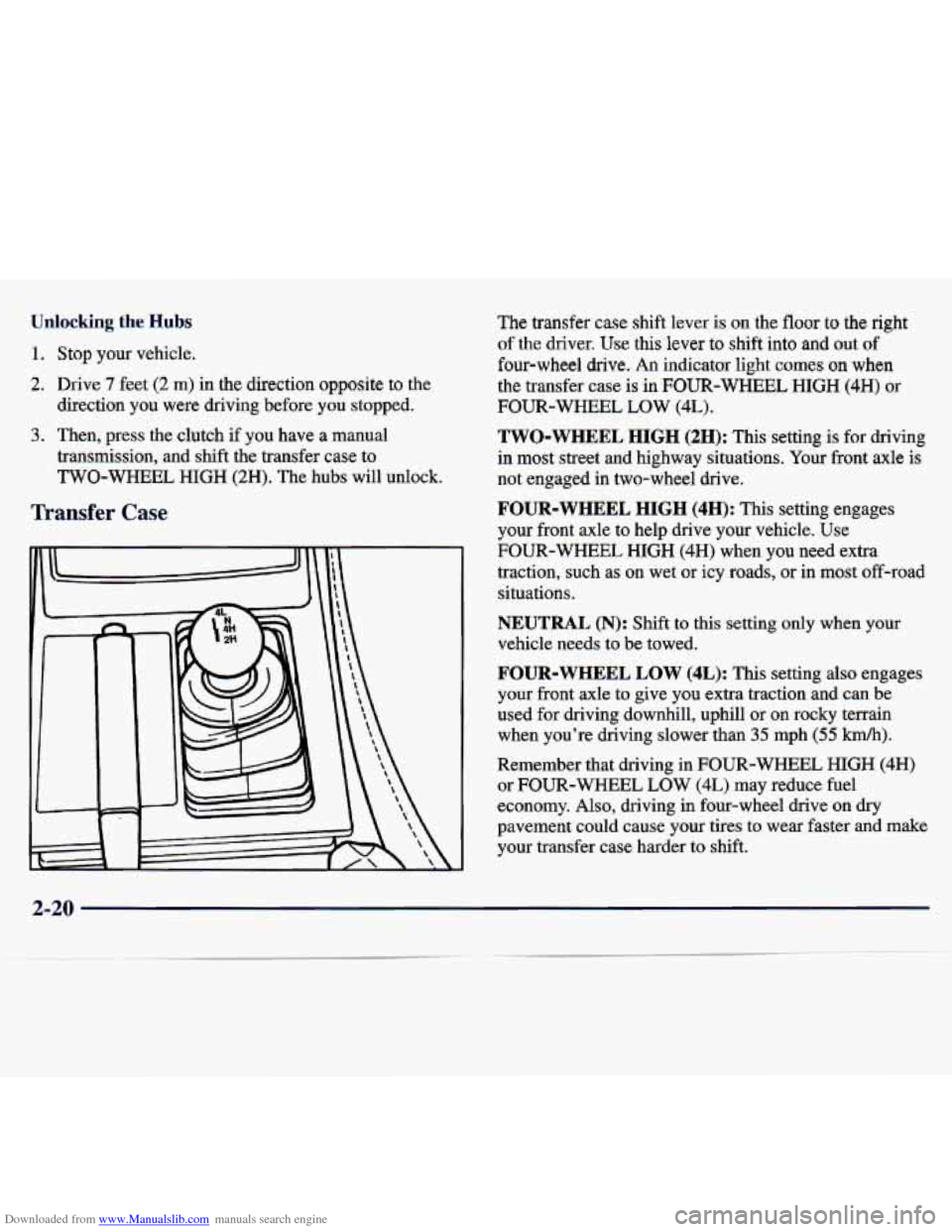
Downloaded from www.Manualslib.com manuals search engine Unlocking the Hubs
1. Stop your vehicle.
2. Drive 7 feet (2 m) in the direction opposite to the
direction
you were driving before you stopped.
3. Then, press
the clutch if you have a manual
transmission, and shift the transfer case to
TWO-WHEEL HIGH (2H). The hubs will unlock.
Transfer Case
E
The transfer case shift lever is on the floor to the right
of the driver.
Use this lever to shift into and out of
four-wheel drive.
An indicator light comes on when
the transfer case is in FOUR-WHEEL HIGH (4H) or
FOUR-WHEEL LOW (4L).
TWO-WHEEL HIGH (2H): This setting is for driving
in
most street and highway situations. Your front axle is
not engaged in two-wheel drive.
FOUR-WHEEL HIGH (4H): This setting engages
your front axle to help drive your vehicle. Use
FOUR-WHEEL HIGH (4H) when you need extra
traction, such as on wet or icy roads,
or in most off-road
situations.
NEUTRAL (N): Shift to this setting only when your
vehicle needs to be towed.
FOUR-WHEEL LOW (4L): This setting also engages
your front axle to give you extra traction and can be
used for driving downhill, uphill or on rocky terrain
when you’re driving slower than 35 mph (55
km/h).
Remember that driving in FOUR-WHEEL HIGH (4H)
or FOUR-WHEEL LOW (4L) may reduce fuel
economy. Also, driving in four-wheel drive on
dry
pavement could cause your tires to wear faster and make
your transfer case harder to shift.
2-20
Page 81 of 386
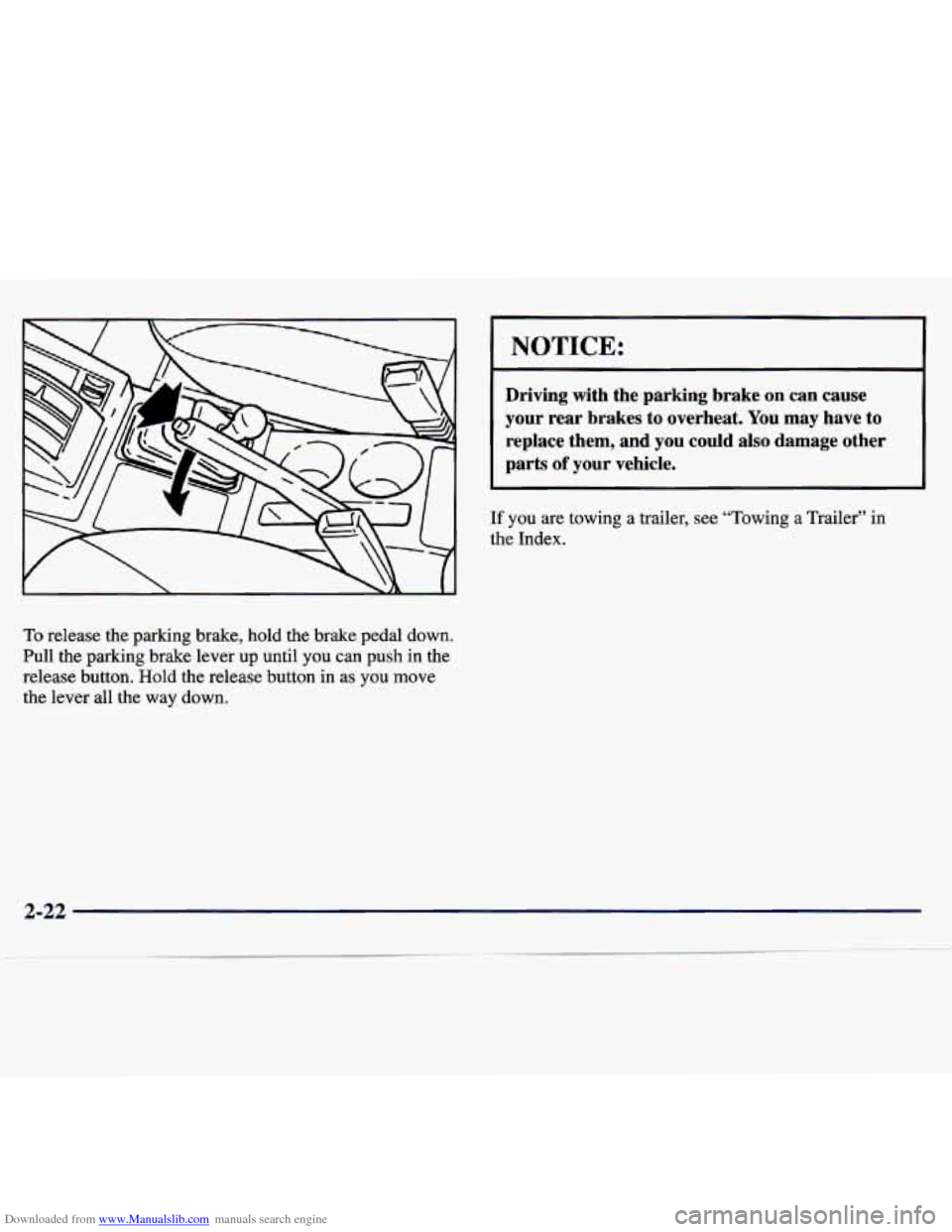
Downloaded from www.Manualslib.com manuals search engine NOTICE:
Driving with the parking brake on can cause
your rear brakes to overheat. You may have
to
replace them, and you could also damage other
parts
of your vehicle.
If you are towing a trailer, see “Towing a Trailer” in
the Index.
To release the parking brake, hold the brake pedal down.
Pull the parking brake lever up until you can push
in the
release button. Hold the release button in as
you move
the lever all the way down.
2-22
Page 82 of 386
![CHEVROLET TRACKER 1998 1.G User Guide Downloaded from www.Manualslib.com manuals search engine Shifting Into PARK (P)
(Automatic Translnission Only)
It can be dz Jerous to get out of you] ehicle if
the shift lever is not full CHEVROLET TRACKER 1998 1.G User Guide Downloaded from www.Manualslib.com manuals search engine Shifting Into PARK (P)
(Automatic Translnission Only)
It can be dz Jerous to get out of you] ehicle if
the shift lever is not full](/img/24/8351/w960_8351-81.png)
Downloaded from www.Manualslib.com manuals search engine Shifting Into PARK (P)
(Automatic Translnission Only)
It can be dz Jerous to get out of you] ehicle if
the shift lever is not fully in PARK (P) with the
parking brake firmly set. Your vehicle can roll.
If you have left the engine running, the vehicle
can move suddenly. You
or others could be
injured. To be sure your vehicle won’t move, even
when you’re on fairly level ground, use the steps
that follow.
If you have four-wheel drive and
your transfer case
is in NEUTRAL (N), your
vehicle will be free to roll, even if your shift
lever
is in PARK (P). So, be sure the transfer
case
is in a drive gear -0 not in NEUTRAL (N).
If you’re pulling a trailer, see &‘Towing a Trailer”
in the Index.
1. Hold the brake pedal down with your right foot and
set the parking
brake.
2. Move the shift lever into PARK (P) by holding in the
button
on the lever and pushing the lever all the way
toward the front
of your vehicle.
3. If you have four-wheel drive, be sure the transfer
case is in a drive gear
-- not in NEUTRAL (N).
4. Move the key to LOCK.
5. Remove the key and take it with you. If you can
leave your vehicle with the key in your hand, your
vehicle is in
PARK (P).
2-23
Page 84 of 386
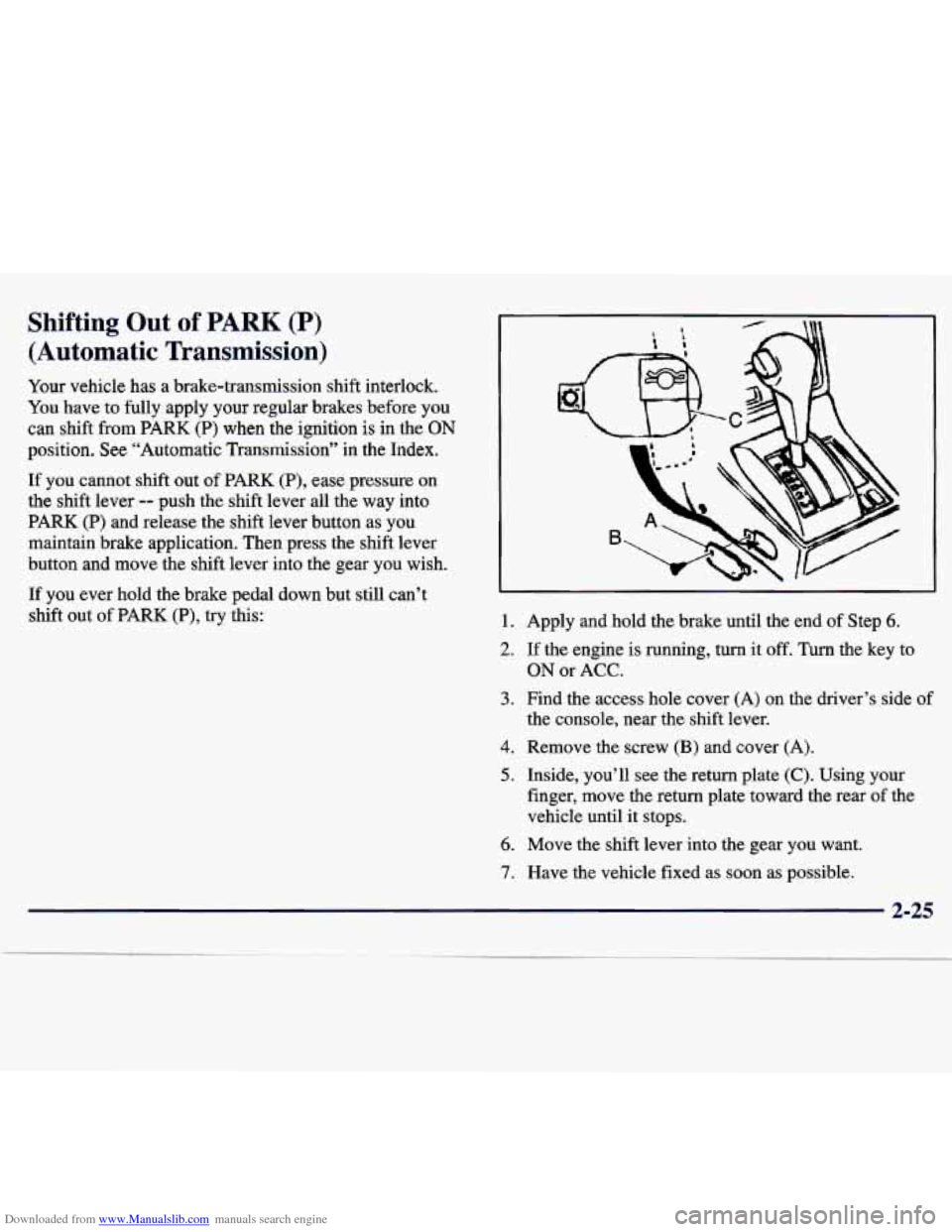
Downloaded from www.Manualslib.com manuals search engine Shifting Out of PARK (P)
(Automatic Transmission)
Your vehicle has a brake-transmission shift interlock.
You have to fully apply your regular brakes before you
can shift from
PARK (P) when the ignition is in the ON
position. See “Automatic Transmission” in the Index.
If you cannot shift out of PARK (P), ease pressure on
the shift lever
-- push the shift lever all the way into
PARK
(P) and release the shift lever button as you
maintain brake application. Then press the shift lever
button and move the shift lever into the gear you wish.
If you ever hold the brake pedal down but still can’t
shift out
of PARIS (P), try this: 1. Apply and hold the brake until the end of Step 6.
2. If the engine is running, turn it off. Turn the key to
ON or ACC.
3. Find the access hole cover (A) on the driver’s side of
the console, near the shift lever.
4. Remove the screw (B) and cover (A).
5. Inside, you’ll see the return plate (C). Using your
finger, move the return plate toward the rear of the
vehicle until it stops.
6. Move the shift lever into the gear you want.
7. Have the vehicle fixed as soon as possible.
2-25
Page 85 of 386
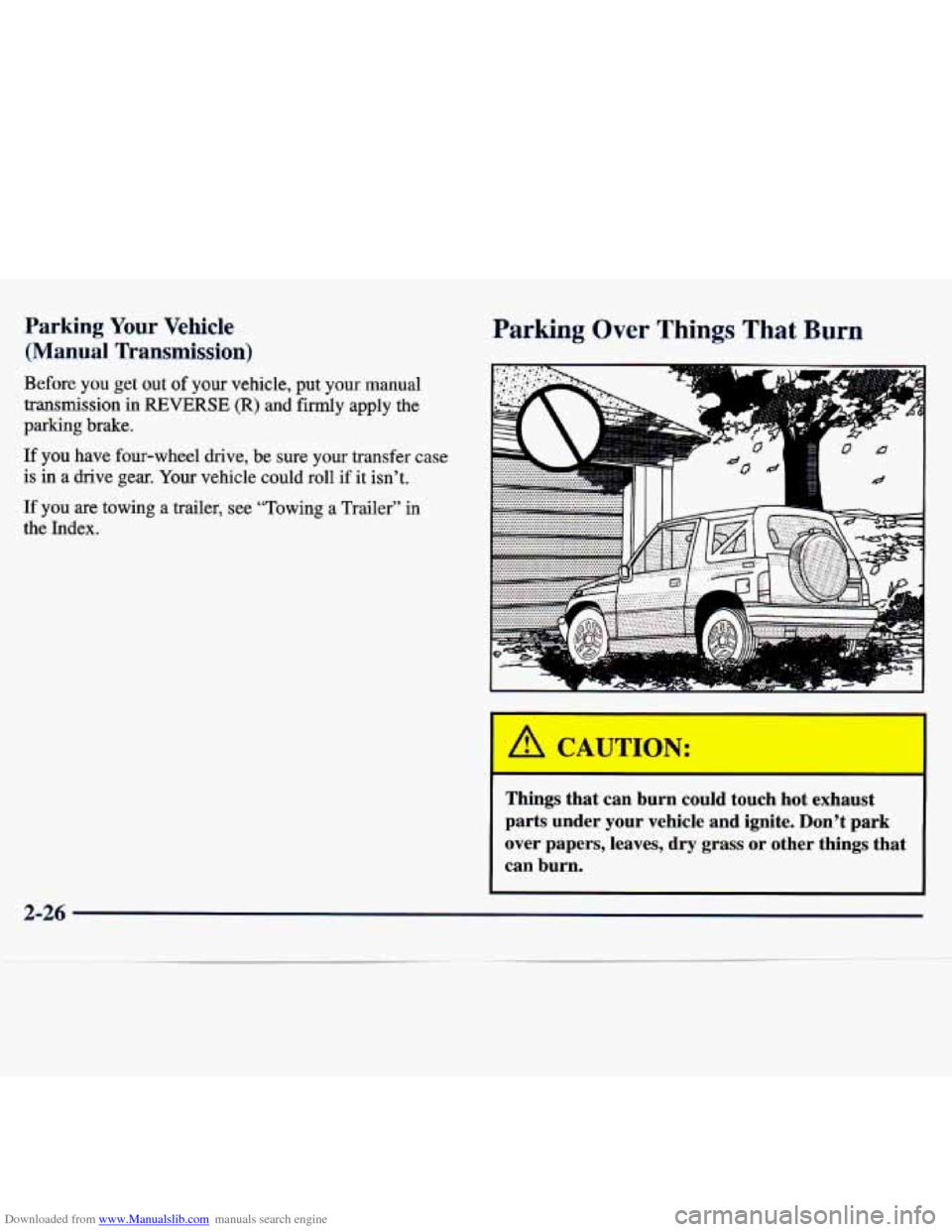
Downloaded from www.Manualslib.com manuals search engine Parking Your Vehicle
(Manual Transmission)
Before you get out of your vehicle, put your manual
transmission in
REVERSE (R) and firmly apply the
parking brake.
If you have four-wheel drive, be sure your transfer case
is
in a drive gear. Your vehicle could roll if it isn't.
If you are towing a trailer, see "Towing a Trailer" in
the Index.
Parking Over Things That Burn
c. .. I
R
Things that can burn could touch hot exhaust
parts under your vehicle and ignite. Don't park
over papers, leaves, dry grass or other things that
can burn.
2-26
Page 87 of 386
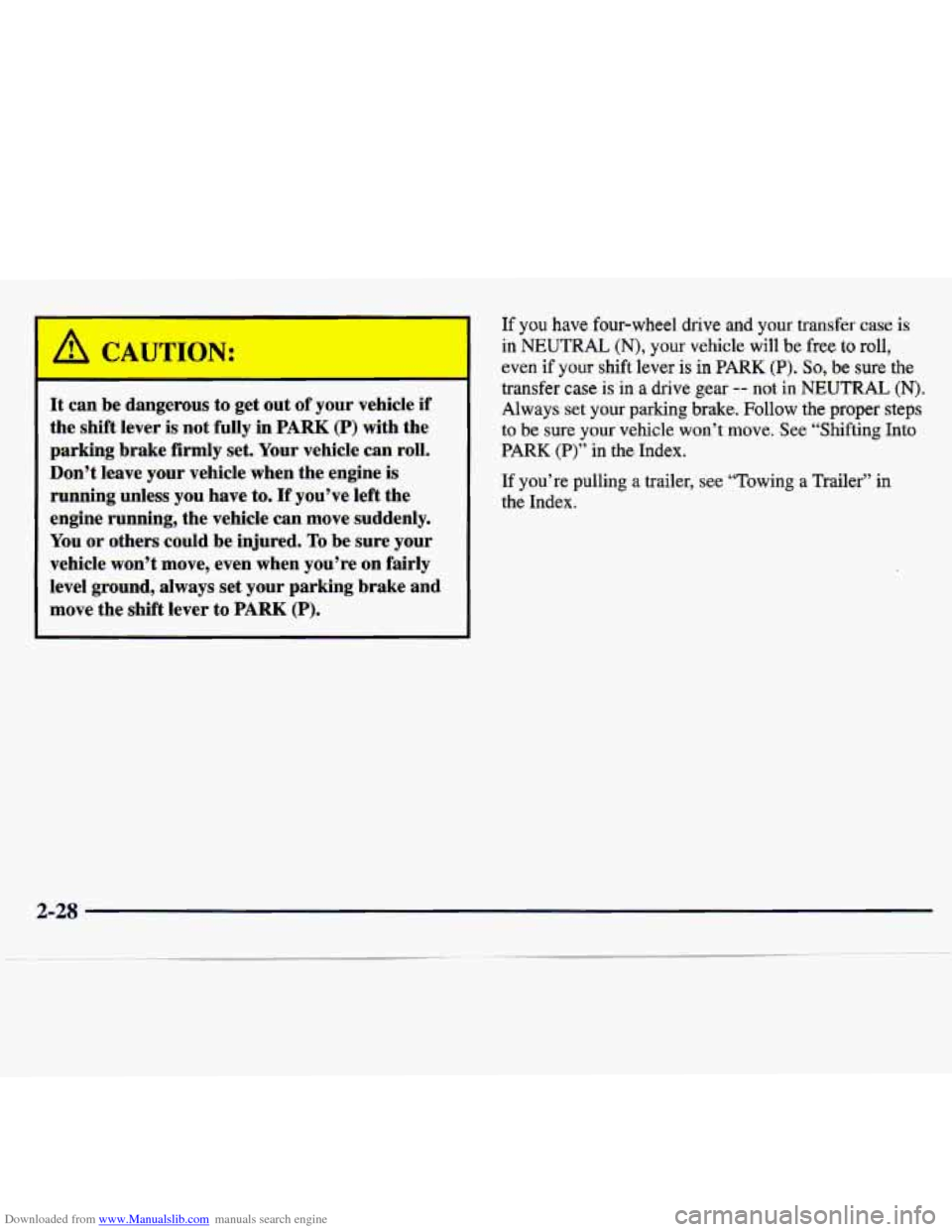
Downloaded from www.Manualslib.com manuals search engine It can be dangerous to get out of your vehicle if
the shift lever is not fully in PARK (P) with the
parking brake firmly set. Your vehicle can
roll.
Don’t leave your vehicle when the engine is
running unless you have to. If you’ve left the
engine running, the vehicle can move suddenly.
You or others could be injured.
To be sure your
vehicle won’t move, even when you’re on fairly
level ground, always set your parking brake and
move the shift lever to
PARK (P).
If you have four-wheel drive and your transfer case is
in NEUTRAL
(N), your vehicle will be free to roll,
even if your shift lever is in PARK (P). So, be sure the
transfer case is in
a drive gear -- not in NEUTRAL (N).
Always set your parking brake. Follow the proper steps
to be sure
your vehicle won’t move. See “Shifting Into
PARK (P)” in the Index.
If you’re pulling a trailer, see “Towing a Trailer” in
the Index.
2-28
Page 90 of 386
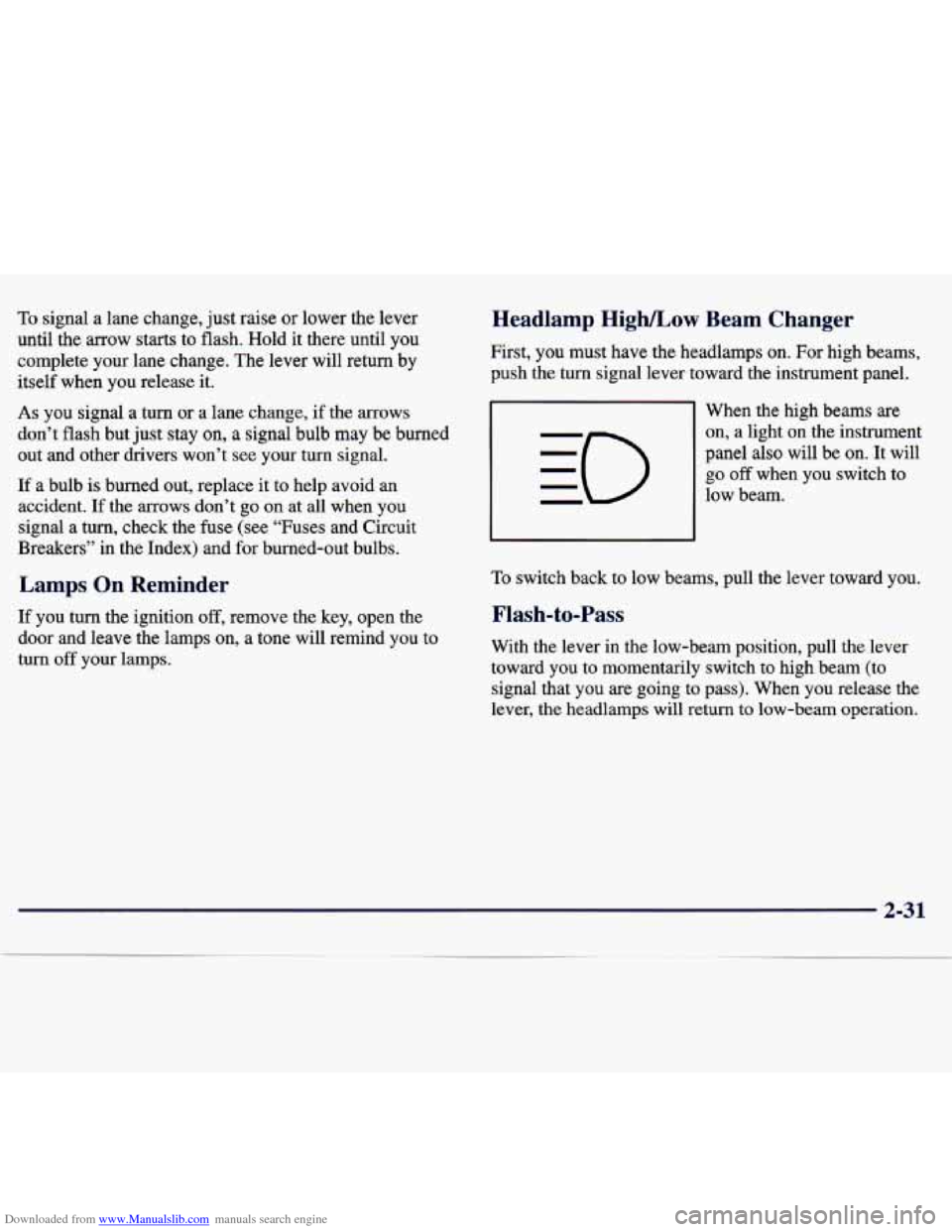
Downloaded from www.Manualslib.com manuals search engine To signal a lane change, just raise or lower the lever
until the arrow
starts to flash. Hold it there until you
complete your lane change. The lever will return by
itself when you release
it.
As you signal a turn or a lane change, if the arrows
don’t flash but just stay on, a signal bulb may be burned
out and other drivers won’t
see your turn signal.
If a bulb is burned out, replace it to help avoid an
accident. If the arrows don’t go on at all when you
signal a
turn, check the fuse (see “Fuses and Circuit
Breakers” in the Index) and for burned-out bulbs.
Lamps On Reminder
If you turn the ignition off, remove the key, open the
door and leave the lamps on, a tone will remind you
to
turn off your lamps.
Headlamp High/Low Beam Changer
First, you must have the headlamps on. For high beams,
push the
turn signal lever toward the instrument panel.
When the high beams are
on, a light on the instrument
panel also will be on. It will
go off when you switch to
low beam.
To switch back to low beams, pull the lever toward you.
Flash-to-Pass
With the lever in the low-beam position, pull the lever
toward you to momentarily switch to high beam (to
signal that you are going to pass). When you release the
lever,
the headlamps will return to low-beam operation.
2-31